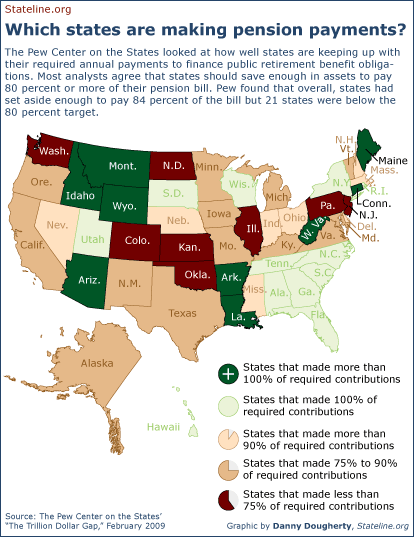 From Stateline.org:
From Stateline.org:
The Pew Center on the States released a report Thursday (Feb. 18) saying that there is a $1 trillion gap between what states have promised to pay retirees and the money they have set aside to cover those costs. New Jersey, the report said, was one of the worst states in keeping up with its required annual pension payments, amassing a $34 billion shortfall in 2008 after finishing with a surplus in its retirement fund in 2000.[…]
The spurt of pension activity in 2010 follows three busy years in states. Last year, 15 states approved legislation to change their state-run retirement systems, compared to 12 in 2008 and 11 in 2007. Most of the reforms centered on reducing benefits, increasing the retirement age, hiking employee contributions and keeping up with funding requirements. The Pew report discusses many of these reforms in greater detail.
The report is excellent and I highly recommend checking it out. Stateline has put together a telling graphic which I hope they won’t be angry at me for reproducing it here. Just nine states are keeping up with their pension payments; 21 states can’t even pay 80% of what they need to put away to keep defined-benefit plans solvent.
Since the plans are defined-benefit, the loss in portfolio value must be made up by increased contributions from the state budget or from employees. Many states are doing neither: just letting the bill run up. Some are still voting to increase benefits as they don’t make payments. Other states (and localities, like our own DC Metro) must cut services or raise taxes to make room for the ballooning public pension payment.
No state budget catastrophe story is complete without some California discussion (Los Angeles Times):
Both the California Public Employees’ Retirement System and the California State Teachers’ Retirement System lost more than a fifth of their portfolio values in the 2008-09 fiscal year, when they had about 87% of needed pension funds in their portfolios.
Since then, CalPERS’ funding ratio dropped to 61% on June 30, 2009, while CalSTRS’ was 77%.
“California has a troubling pattern of not paying its annual required pension contributions in recent years,” said Susan Urahn, managing director of the Pew Center on the States.
And pensions are only part of the problem: The two retirement funds have set aside less than 1% of the $62 billion they need to cover lifetime health insurance benefits for retirees.
Illinois gets the reward for worst public pension system in the nation:
Illinois was rated the most troubled pension system in the nation, with a 54 percent funding level and a total liability of more than $54 billion, according to a study of state-administered pension funds being released today.[…]
Share this article